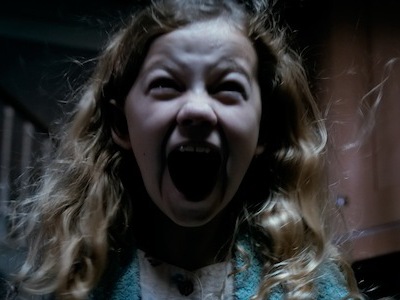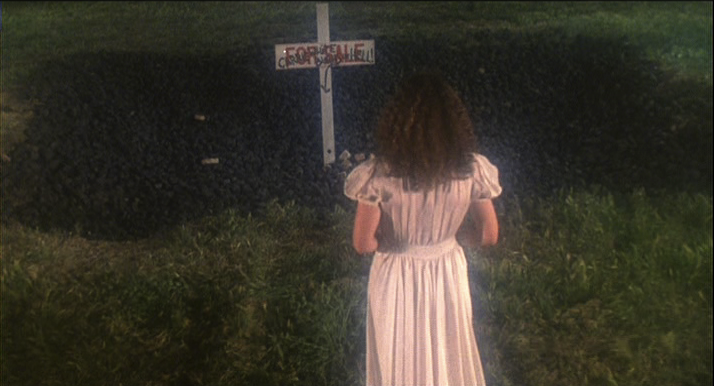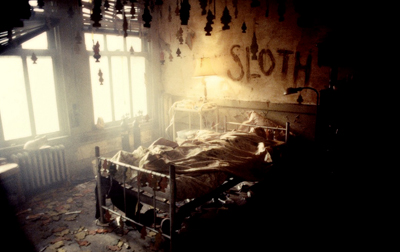 Michael C here. I recently caught up with Andres Muschietti’s Mama and found it to be a decent little chiller with one particularly irksome habit. It is packed end-to-end with cheap jump scares. It’s as if the studio insisted the director include a quota of brainless “Boo!” moments amid all the creepy suspense stuff that takes actual filmmaking skill.
Michael C here. I recently caught up with Andres Muschietti’s Mama and found it to be a decent little chiller with one particularly irksome habit. It is packed end-to-end with cheap jump scares. It’s as if the studio insisted the director include a quota of brainless “Boo!” moments amid all the creepy suspense stuff that takes actual filmmaking skill.
Savvy filmgoers understand that jump scares are the worst. Apart from the fact that it requires roughly the same level of craft to startle someone with a loud noise as it does to zap them with a seat buzzer, they have the added drawback of creating distance between the audience and the film. They release tension, rather than build it. This explains their popularity among teenagers who see horror movies as a carnival ride, doling out empty “scares” with mechanical timing.
So finding a minefield of these cheap shots in another otherwise capable spook story like Mama got me thinking. Are there any defensible examples of the jump scare? Or is it an artistic sin every time it’s trotted out?
jump scares after, um, the jump.
By my accounting a genuine “jump scare” requires three elements: the shock has to emerge from out of nowhere, it must follow a period of quiet or calm, and a loud stinger must accompany it on the soundtrack. As I pored through memories of the biggest movie scares I noticed an interesting thing. Those scares that fit the definition perfectly, like Alan Arkin’s leap from the shadows in Wait Until Dark, seem lame and manipulative in retrospect. While those moments that held up well strayed outside the parameters of what we consider “jump scares”.
Take the “Sloth” scene from Se7en. I disqualify it because Fincher hides the shock in plain sight the whole time, toying with the viewer’s assumptions rather than throwing in a surprise from out of frame. Likewise, the diner nightmare scene from Mulholland Dr. flat-out tells you a shocker is coming and still manages to pull a heart-stopper through a mixture of reverse psychology and plain old killer timing. The “We’re gonna need a bigger boat” scare from Jaws does not use a soundtrack stinger at all, instead playing without a score until some ominous, orchestral rumbles emerge on the soundtrack. As for the big reveal at the end of Don’t Look Now, the lack of a traditional horror score puts no safe distance between the audience and the film as the image of the figure in the red coat is permanently etched into the fear lobe of the viewer’s brain.
And what of the mother of all jump scares, the final scene of Carrie? While I can’t argue it doesn’t meet the criteria I outlined, I would make the case DePalma elevates it above the classification. For one thing its impact is not just based on a random gotcha but is the cumulative effect of the scene’s surreal (but not too surreal) details. For another thing, the jolt on the soundtrack isn’t a true shrieking stinger but is a dramatic turn in a proper melodic score.

I’ve only been able to think of only three honest to God jump scares that fit the definition and still rise above the laziness associated them: Martin Balsam's death in Psycho, the creature reveal from The Descent and the Large Marge scene from Pee Wee’s Big Adventure. The Descent earns its jump scare with forty-some minutes of restraint and suspense building. As for the glory that is Large Marge, Burton gets away it with awesome execution, simple as that. That moment catches the viewer so completely off guard, and its use of stop motion is so unexpected (and that sped up, ghoulish cackle is so crap-your-pants terrifying) that it deserves to be an exception to the rule. Psycho gets away with it because it's Psycho and the musical stinger in question is the Psycho theme. You can't really be pegged for leaning on horror cliches when you're busy inventing them.
The concepts of the movie scares is too broad for me to cover single-handedly so I turn it over to the horror buffs in the comments. What say you? I find that defensible uses of the jump scare do in fact exist, but are an extremely rare species. Am I denigrating a time-honored horror tradition? What glaring examples have I omitted?
You can follow Michael C. on Twitter at @SeriousFilm. Or read his blog Serious Film.
